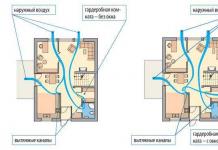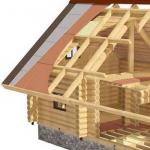Probably the most convenient device for storing things is a dressing room. After all, it’s really great when all the details of the wardrobe are in one place and you can immediately assess how well the set you’ve just chosen fits together, rather than running from room to room - take it, try it on, look. Moreover, you can make a dressing room in a very small area: the minimum is 1.5-2 square meters. EVEN in a small apartment it is possible to fence off such space. Moreover, it has been noticed that it is more convenient to use them if the dressing room is assembled with your own hands. It's simple: no one knows your habits better than you and can put things in the right order. So, let’s start creating our own dressing room.
Wardrobe sizes
Our realities are such that most people live in small apartments, where every centimeter counts. Therefore, issues of size often play a decisive role. The smallest dressing room can have an area of 1.2 - 1.5 square meters. meters. It is a rectangle with sides 1.5 * 1 meter or so. Also, a small dressing room can be corner - this option is even more spacious than a rectangular one of similar size: with an equal area, the length of the sides on which shelves and storage systems can be placed will be greater.
The smallest dressing rooms: 1.5 by 2.5 m and 2 by 2 m
A rectangular mini-dressing room should have a width of at least 1.2 m when things are placed on one side, and at least 1.5 m when placed on both sides. The depth should be such that it is possible to “enter” there. This is what mainly distinguishes dressing rooms from sliding wardrobes, and also the ability to install any doors.
Ventilation and lighting
Even in mini-dressing rooms, and even more so in large ones, ventilation is necessary: in a closed room, a musty smell quickly appears, which no perfume can mask. Therefore, even when planning, find a way to make ventilation in the dressing room.
The principle of its design is no different: in the upper part of any of the walls, preferably further from the door, an exhaust hole is made into which a fan is inserted. The inflow is provided either into the gap under the doors or into special inlet openings located just above the floor level. They are closed with decorative grilles. The outlet of the ventilation duct should be into the general ventilation system; you can use plastic boxes to take it outside or under the roof of a private house. Air exchange organized in this way effectively maintains the normal state of things.

Principles for organizing ventilation of a dressing room through a bathroom
When choosing a fan, you should pay special attention to the noise level. Since dressing rooms are often located in or close to bedrooms, noise should be kept to a minimum. It can be controlled automatically or turned on/off using regular or.
The lighting should be bright. Firstly, this is necessary to quickly find things, and secondly, dressing rooms are often used as fitting rooms to immediately see how well the selected items fit together. The mirror is usually placed on the door or mirrored doors are made. In this case, the light should be directed not only to the shelves and storage systems, but also to the fitting area.

You can use lamps of any type, but it makes sense to make them turn on from motion sensors. They opened the doors - the lamps came on, there was no movement, they turned off. There is another option for swing doors: there are lamps with buttons that light up when the door is opened and turn off when they are closed.
Where to do
Even in small apartments there are “appendicitis” that cannot be used normally. This is where you can make a dressing room.
Another popular option is a pantry. In this case, everything is generally simple. You remove everything unnecessary, change the doors and install the appropriate content: racks, racks, baskets, shelves.

If there is nothing like this in the apartment, they fence off part of the room - the end or the corner - you need to look at the layout. The good thing about a corner dressing room is that it allows you to use the most difficult areas to arrange, namely the corners. Especially if there are closely spaced doors in two adjacent walls. This zone is considered “dead”: you can’t put anything there except a small corner shelf: everything will get in the way. About the same option - two windows or a window and doors.

If the area turns out to be too small, it is possible to increase it a little, making the wall not flat, but with the middle extended slightly. This will not reduce the area of the room much, but much more things can fit.

They are also made on the loggia - by making part of the glazing opaque or by building a wall. Only here you can’t do without insulation - it’s unpleasant to wear cold clothes in winter.

The second option is suitable for wide loggias. In them, shelving can be placed along a long wall.

In the corridor or hallway, a corner or “appendix” is also fenced off, if the layout allows. Here everyone can decide only by location: there is a place for this or not.
A dressing room is most appropriate in the bedroom. This is simply the best place to store things: in the sense that it’s more convenient to dress here. Therefore, for these purposes, part of the room is fenced off. In this case, this technology has long been known and worked out to the smallest detail. It won’t take much time even if you have no experience: a maximum of two to three days for assembly and finishing.
If you make a partition from gypsum board or gypsum board according to all the rules, you will need double cladding, and this will “eat up” centimeters, or even meters, of area. Therefore, most often they are sheathed only on the outside, but in two sheets with overlapping seams. When assembling the frame, do not forget to make reinforced racks for fastening the door. With single cladding, exposed profiles remain inside, but it is convenient to hang shelves-baskets for things on them. If you plan to do this, then take them with a thick wall so that they can hold the weight properly.

The partition can be made from or slabs. This is an option for those who do not like to bother with putty. But you need to choose a lamination that will fit into the interior without any problems.
Doors for dressing room
What’s great about a DIY dressing room is that you can install any kind of door: sliding, “compartment” type, accordion type, regular hinged, hinged on rollers. You can even get by without them at all. This option is called a wardrobe-rack, but then everything will have to be kept in perfect order: everything is in sight. The most budget option is thick curtains or something like a Japanese curtain.

If the front wall is large, part of it can be stationary, and part can be occupied by doors. In this case, you can also somehow use it on stationary walls. If desired, the doors can be made full width, or consisting of fragments.

Option for a dressing room in the attic: a side part with a low ceiling is occupied for it. Full-width doors make it easier to get to things
The design can be anything as long as it fits into the appearance of the room. If desired, they can be made to match the walls so that they are not visible, or they can be bright and conspicuous.
Arrangement: filling and storage systems
If the area is limited, there is no point in making furniture from wood, MDF or chipboard into the wardrobe. They take up precious centimeters of space and also interfere with air movement. Another disadvantage is that redoing something is problematic.

“Standard” type furniture takes up too much space
Recently, the general trend is the installation of lightweight metal storage systems. They are modular and assembled on special racks. Racks can be attached in two ways - to the walls or to the ceiling and floor: different manufacturers make different systems. And everything that is needed is hung on these racks.
The racks can have notches along the entire length, which makes it possible to install any element at any height. These are the most mobile systems that can be modified easily and simply - simply by moving them from one row of notched hooks to another, arbitrarily changing the height of the shelves and baskets, and other elements.

There are racks of rectangular cross-section, with grooves cut on both sides. The necessary components are attached to the clamps in these grooves.

Please note that there are different shelves and drawers - made of wood or wood materials, metal - chrome-plated or painted. They can be retractable, they can be placed one on top of the other or on shelves.
All these systems are sold: racks and a list of various components. But they are produced mainly in European countries, so the price is high. An economical option for dressing room equipment can be made independently from a round chrome-plated furniture pipe and various fasteners for it. It turns out that this furniture is not as mobile as we would like, but it costs significantly less.

Devices for placing clothes
In addition to standard and not so standard drawers and shelves, there are interesting special options. For example - skirts or trousers. Special guides on which the transverse strips are attached, sometimes they have clips. They allow you to hang your skirts/pants straight and not be afraid that they will fall. It is convenient if such a hanger extends, allowing you to inspect all the contents.

One of the options for filling a dressing room is a bracket for skirts or trousers
This device can be replaced with a simpler one, but much cheaper - a hanger with crossbars located one below the other. It's not as convenient, but it allows you to organize your clothes just as well.

There is a retractable design for ties, only it is usually oriented differently and extends out in length, although not everyone likes such a system, but prefers folded drawers into cells.

There are several ways to place hangers. The simplest are pipes, the more economical (in terms of space use, but not in terms of money) are tie-like retractable brackets.

Another device is a pantograph for clothing. This is also a pipe, but capable of descending. A kind of lift for clothes. This device allows you to use the space right up to the ceiling, without compromising your comfort. It can be attached either to the side walls (a more common option) or to the wall. There is a handle-bar attached in the middle of the pipe, by pulling which you lower it to a horizontal position. The carrying capacity of such devices is usually small (up to 18 kilograms), so they are used for lightweight clothing.

Furniture pantograph - for light (by weight) clothes
Shoe storage systems
Problems often arise with storing shoes: some people have dozens of pairs of them, so it’s time to arrange separate dressing rooms for them. But among the standard sets of equipment there are several interesting ones for storing shoes.
Let's start with the retractable system. IKEA has it. Pins with shoe modules mounted on a movable frame. Convenient, compact.

There are mini chests of drawers that do not take up much space, but are hung on the walls, and there are hanging organizers that can be easily placed on a horizontal pipe.


These are mini chests of drawers on the wall
In general, there are many interesting ideas for shoes that allow you to place them compactly and at the same time conveniently. Some are in the fogo gallery.
 Such “rotating” boxes are very convenient not only for shoes, but also for small items and linen. A way to store boots is on hangers with clothespins
Such “rotating” boxes are very convenient not only for shoes, but also for small items and linen. A way to store boots is on hangers with clothespins
There are very inexpensive options. For example, the seasonal one, which is currently in use, can be stored on a grid with rearrangeable hooks or wire shelves. You've probably seen similar ones in stores. This is a mesh or perforated panel on which hooks/shelves are hung. Convenient: you can move it under any type of block, make the distance larger or smaller.

An economical option for storing shoes - a mesh with hooks and shelves
Hanging such a grid is not a problem - even on a wall, even on the side surface of a cabinet or door. Hooks and shelves simply cling to the crossbars. This option is ideal if you are short on money and space. If you like the idea but need something more presentable, make or find a perforated metal shield on the frame. Hooks are also inserted into it with a bang.

Modification - shield with hooks
In general, when arranging a dressing room and on a limited budget, you should look for storage systems not in furniture stores - online or offline. It’s better to look at sites that sell commercial equipment. There are many interesting devices that save space: stores also try to display the maximum amount of goods in a minimum area. For example, these are shoe racks.

If you attach wheels to the first one, you get an excellent retractable system. The price of such equipment is much less than similar equipment, which is sold in furniture stores.
Making a dressing room project
As you can see, there are a lot of ideas for equipment and storage systems. But so that it doesn’t turn out that the great thing you bought simply doesn’t fit into your wardrobe, you need to draw a plan on which to indicate all the dimensions and dimensions. It is drawn to scale, then you mark on it those parts that must be present. They are drawn to the same scale. If everything “fits in”, armed with the dimensions (you have them, or you can measure them in the drawing and, using the scale, calculate the real values), you can go to the store to choose systems.
There is another approach. Find out the dimensions of the devices and systems you like (installation dimensions), cut them out to scale from cardboard or thick paper and try to combine everything. If it works, great, you can buy it. No - look for other options. As a result of your efforts, you should end up with a layout approximately like the one in the photo.

To make it convenient to use the equipment and get things out, you must maintain the following distances:
- minimum distance from shelf to shelf:
- when storing things - 30 cm;
- when storing shoes (without stilettos) - 20 cm;
- shirts, jackets, jackets - 120 cm;
- trousers:
- folded in half - 100 cm;
- length - 140 cm;
- compartment for outerwear - coat - 160-180 cm;
- for dresses - 150-180 cm.
At the very top we reserve space for clothes from a different season or rarely used items. There is often space for a vacuum cleaner at the bottom, and a built-in ironing board is installed in one of the cabinets.
For those who like to work with their hands, here are several diagrams with dimensions so that you can equip your dressing room with your own hands (at least partially).

Drawing of a shoe rack with dimensions


Shoe storage system made of plastic pipes…
A large dressing room is every woman's dream. Not every apartment, even of a decent size, can boast a separate room for storing clothes and shoes. But almost any living space of the Khrushchev type has a storage room. Many people use it for its intended purpose: they store things that are often used in it, this can be seasonal clothing, household items (for example, a vacuum cleaner, broom, mop). But such a place can be used to much greater benefit. We will tell you how to make a dressing room from a pantry with your own hands quickly and inexpensively.
Features of the dressing room
Converting a closet into a dressing room allows you to solve a number of important problems. There is no need to purchase or individually order a large, spacious wardrobe, which will significantly save the family budget. You can rationally zone rooms by changing their parameters, if possible. Most often, storage rooms in “Khrushchev” apartments, which, as is known, are small in size, undergo such re-equipment. Dressing rooms were originally organized in such dwellings. But over time, due to the lack of excess free space, they were gradually turned into storage rooms in which various things for household needs were stored.
Making a dressing room back from a closet with your own hands is quite simple if you know what finishing materials to use, what devices to equip it with, and how to arrange them correctly.
Inconvenient niches and closets in modest-sized homes are the most noticeable, but their disadvantages can easily be turned into advantages by completely refurbishing them and filling them with shelves and shelves, drawers and rods.
If your apartment has a very small storage room or no storage room at all, then you can make adjustments to the organization of the hallway space. Most often, this is where storage for things will not disturb anyone; there will be free space for it.
The dimensions of the future dressing room depend on the capabilities of a particular apartment and the needs of its owner. But if we talk about average parameters, then usually the height of this room is up to the ceiling, the width depends on the capabilities of the wall (1-2 m), the depth is at least 1 m. Depending on the desires and capabilities of the owner, the internal space can be filled with shelves, racks, build mezzanines, install hangers.
Often apartments have niches. If there are any in your apartment, arrange a dressing room in their place. To do this, you only need to install a door (can be made of wood or MDF), construct a mezzanine, shelves, and equip it with hooks for clothes.
If there is simply no storage room in the apartment that could be converted into a room for storing things, then you need to build it as inconspicuously as possible. To do this, make partitions from plasterboard, in which an area is left for the doorway. In such a small room, the entire space is used completely, right up to the ceiling.

If you have a storage room...
There are two ways to make a small dressing room from a closet with your own hands:
- replacing a pantry with a cabinet (it’s simple and quick to execute);
- carrying out the entire complex of work with your own hands.
In the first case, the doors and partitions between the corridor and the storage room are completely removed. Next, contact a furniture manufacturing company to order a cabinet of the appropriate size. It is installed in the niche formed after dismantling the partition. It is best to choose a closet with sliding doors: this will save hallway space. This design, additionally equipped with mirrors, will visually enlarge the room. This type of pantry remodel will save you time.
If you choose the second option, you should prepare for a longer process.

Cleaning out the pantry space
First you will have to remove all the things from the room, select those that still need to be used. Get rid of unnecessary old trash: there is usually plenty of it in such rooms. Next, remove the door from its hinges. If necessary and there is such an opportunity, then the shape of the future room is changed, for example, to U-shaped or linear using plasterboard structures.
Measurements
To calculate the parameters of the future dressing room and the amount of materials needed, you will need a tape measure and a marker (the result of the marking is applied to them; you need to work with it carefully, since after installing the shelves and racks, the marks should not be visible).
Blanks
It is necessary to prepare materials for future shelving and create blanks for them. Cut the material from which you plan to make them according to the measurements taken.
Fixing shelves
The shelves are secured in three ways:
- using dowels;
- metal corners;
- wooden frame (made of timber).
Choose fasteners at your discretion. The main thing is that the structures are securely and firmly fixed. But the first method is the least practical, since a shelf mounted on protruding dowels is unstable and can tip over when supported on its edge. Therefore, it is worth choosing corners or a frame made of timber.
The finished structure made of wooden blocks or chipboard is fixed on the wall in the places marked with a marker. This is done using a screwdriver and self-tapping screws or special glue.
At this stage, regular checking of the correct location of the structure using a small building level is required. Next you need to install the shelves.
Do not forget that chipboard shelves must be edged at the cut points: this way you will be able to avoid damage to things on the raw edge.
Rod mount
Fasteners for the rod are installed after installing the shelves. It is better to purchase such elements in a store that sells furniture fittings.
In order to be able to place the required number of hangers (trampels) on the bar, the width of the shelves must be at least 58 cm. The distance between the shelves and the bars is no more than 5 cm.
You can place clothes rails at different heights. The height of the room, divided into two parts, makes it possible to install several rods with hangers. In this case, it is necessary to take into account the length of the clothes that they plan to hang on them. The method of dividing the height is rational if you are sure that there will be no long floor-length dresses on the hangers.
After installing the shelves and rods, the former pantry is equipped with full lighting and doors are installed.
Surface finishing
Perhaps in the future dressing room you will have to update the walls, ceiling and floor, and change the door. If the walls of this room are in decent condition, then the cheapest and most practical option is to paint them. High-quality painted surfaces do not require special care; they can be washed with water and various detergents. When the next repair is needed, such walls can be put in order without dismantling the shelves (they just need to be covered with a film to protect them from paint). Also, the side surfaces can be covered with wallpaper or covered with MDF panels. In the latter case, you will have to build a frame from bars or metal profiles, which will “eat up” precious centimeters.
Carpet, laminate or linoleum can be used as flooring.
The ceiling in the dressing room can be painted, just like the walls, or a tension structure with built-in spotlights can be used.
Mirror
A mandatory element of a dressing room is a mirror. To save space, it is hung on the inside of the door. Then the room is filled with various drawers, shelving, shelves for shoes and hats, rods for long items, and compartments for storing smaller items of clothing.

How to turn a closet into a dressing room with your own hands
You can make a similar design using wardrobe pipes equipped with special fasteners. Such systems consist not only of pipes, they are equipped with holders, shelves, and doors. In this case, the dressing room is assembled like a construction set. Such models can be purchased at furniture stores. Their main advantage is the ability to change the position of shelves and ceilings when necessary.
Remember that the future dressing room should not stand out from the overall interior of the apartment. It definitely fits into her style. Therefore, special attention should be paid to the door. You can make it original and interesting with the help of stained glass windows made of colored glass or its imitation. Drawings on the facade will successfully emphasize the design of the common space, making it more attractive and sophisticated.
The interior furnishings of a dressing room converted from a storage room should be as functional as possible. For the most economical use of its space, various drawers and shelves for small things are even hung on the doors.
In order not to clutter up the already too limited space of the former pantry, use designs for wardrobes of the “loft” and “bazeri” types; they include mobile cabinets that can be removed to another place if desired. Such systems will make it easier to arrange such a room with your own hands.
A small pantry can be converted into a closet with many built-in structures, open and closed shelves, even extending outside the room.
Converting a storage room into a dressing room, located along the entire length of one of the walls, is an interesting option that can be used in Khrushchev-era apartments. In this case, you can use the second entrance to the room. Thus, the former storage room will divide the rooms and acquire a separate entrance. This is very convenient, since it will not turn into a dead end filled with things, and shelves can be placed along its walls and ends, or you can install a hanger for long things along the entire wall. This dressing room is convenient and practical.
How to organize the space of a small dressing room
A small room needs to be carefully planned in order to rationally use every centimeter of it.
If you can’t change the space of this room, then it’s wise to place all your things on small shelves (it’s convenient to arrange everything on them and find them if necessary).
At the bottom there are usually drawers designed to store shoes. At the top there are shelves for storing seasonal items. In the middle are items of clothing that are used regularly.
In a small dressing room you need to leave space (about 1 m) for things that should hang on a hanger.
To make the room convenient to use, it must be equipped with lighting devices.
Door: necessary or not?
If your dressing room is in a separate room, then you need to install a door. It will divide the space and add completeness to the overall interior.
If you remove the doors, the pantry can be turned into a shelving unit; shelves moved outside can become part of another room.
The structure, located in the corner, can be closed on one side with a plasterboard partition, and left partially open on the other.
The pantry is sometimes combined with a closet, in which case the door must be removed.
It is convenient to use a dressing room with sliding doors or accordion-type structures: this saves space, which is important for Khrushchev-type apartments. Hinged models are mounted if there is enough space to open them.
You can close the doorway in the storage room with a thick curtain that can completely close it. This design is hung on a cornice fixed with dowels or screws. This option will help reduce costs for dressing room equipment and allow you to easily change the design of the entire room.
If you decide to place rooms for storing things and shoes in a niche located in the bedroom, then use a structure with frosted or transparent glass as a door. It will help to visually change the parameters of the room towards larger ones.
As for the former storage room, installing transparent doors there is undesirable, otherwise your things will become public knowledge.
A good option is a door decorated to match the tone of the wall (for example, trimmed with wooden panels or covered with the same wallpaper).
You can, on the contrary, install the same structure as in other rooms. This will emphasize a unified style solution for the interior of your home.
All about shelves
Shelves for a dressing room can be made from chipboard, laminated chipboard, or natural wood. Chipboard with melamine coating is highly resistant to mechanical damage and moisture. When using it, it is necessary to apply a special edge of the appropriate color to the cut areas.
If you decide to make a dressing room with your own hands, then you will need certain fasteners. So, to fix the shelves, you can choose mensolo and shelf holders.
You can quickly install storage structures using corners. They are able to withstand heavy loads.
FIX mounts look very neat. If necessary, the shelves installed on them can be easily dismantled.
Pelican-type fasteners are capable of holding shelves made of materials of various thicknesses.
Telescopic drawer guides are more convenient and durable.
You will also need wardrobe hooks, handles, plugs, and awnings.
If you plan to install compartment-type doors in the dressing room, then you need to purchase the appropriate components.
There is no need to build shelves according to the principle, the larger and wider they are, the better: on structures that are too deep, things will have to be stacked in two rows, which will soon lead to disorder. If your clothing storage room is not too small, then it is better to install pull-out shelves with telescopic guides. You can also install drawers below. Accessories and small wardrobe items can be stored in small drawers equipped with inserted compartments. If you think that you are unable to build such structures, then you can simply install ordinary shelves on which you place boxes made of paper, plastic, and baskets of various sizes.
Lighting
To use the dressing room most conveniently (it has no windows), it is necessary to equip it with lamps. Such a room needs lighting in every corner to make it as quickly and comfortable as possible to select and search for things in it.

Functionality or original design?
A DIY wardrobe should be not only functional, but also aesthetically attractive.
Today in construction stores you can buy ready-made racks for its equipment. They are practical and lightweight. But there is nothing original in such designs. Their faceless doors can be transformed with a little imagination. Paint them with special paints, decorate them with unusual handles or decorative elements, and they will become a real decoration of the overall interior.
How to make your own dressing room from plasterboard?
To make a dressing room with your own hands, you will need the following tools: tape measure, building level, marker or pencil for marking, saw, hammer, jigsaw, screwdriver, drill or hammer drill, grinder (depending on what kind of frame you plan to make), stepladder, brush, roller, container for varnish or paint, eye and hand protection.
- Draw up a detailed drawing of the future structure, take measurements, and calculate the amount of materials. Even if you are carrying out such actions for the first time, think through everything carefully, every little detail in such a matter is important. This will allow you to avoid unnecessary expenses on purchasing material that may subsequently remain unclaimed or on purchasing what is missing.
- Mark the walls.
- Mount a wooden (the bars can be of different sizes depending on where they are used in the structure) or metal frame. Start with a beam placed horizontally across the ceiling. It will become a guide for the surfaces of the future dressing room. The frame is optional if you plan to have a shallow walk-in closet like a built-in wardrobe. In this case, you can attach chipboard sheets to the walls, which will become load-bearing partitions.
- Install vertical supports every 60-70 cm (no more than this).
- Install the cross beams: they are needed for further fastening of various shelves, drawers, and hangers.
- Cover the frame using self-tapping screws with sheets of plasterboard. If necessary, you can lay materials for additional sound insulation and wiring for lighting inside such a structure.
- Seal the fastening points with construction mixture. Treat the walls with primer and let it dry completely. After this, the surfaces can be plastered, painted, or wallpapered.
- Install the doors.
- Secure all necessary shelves, pull-out structures, and hangers.
DIY shelving
If you want to save money when converting a pantry into a dressing room, then make your own storage shelving. The disadvantage of self-made structures is that they are not always aesthetically pleasing. Ready-made shelving purchased in stores has a special coating that allows you to hide external imperfections.
Models made by yourself can be varnished, painted, wrapped in self-adhesive film, or veneered. Wooden structures must be pre-treated with an antiseptic.
Such a dressing room will decorate the interior of your home and will look attractive both outside and inside.
Self-made shelving will allow you to decorate your dressing room inexpensively and in accordance with your needs.
Remember that only a carefully developed plan for the future room for storing clothes and shoes, taking into account the features of its contents and equipment, the characteristics of your everyday life (number and types of shoes, length of clothing, the presence of jewelry and various accessories) will allow you to create a truly comfortable dressing room.
If your apartment has a storage room, then consider yourself very lucky and all you have to do is find out how to make one out of a storage room? Dressing rooms become more and more popular every year, and not everyone can allocate space for this modern miracle of planning. Therefore, despite the small dimensions, today we will learn how to make a dressing room from a pantry with your own hands.
There are two options for how to make a dressing room from a pantry. The first option is very simple and quick to implement. Its essence is to demolish the doors near the pantry and remove the partition. In the resulting space, you just need to order a wardrobe and then install it. As a result, having spent very little time and effort, you will get a new dressing room from the pantry.
The second method is much more labor-intensive, but more thorough. In order to make a dressing room from a pantry with your own hands, you need to empty the entire pantry of its contents. Finish the walls and floors, put them in order or update them as necessary. The main and painstaking work begins after applying a cosmetic shine to the pantry. Now you need to build your own shelving, preferably from ceiling to floor. On the racks, properly organize storage places for things, in the form of shelves, compartments, hangers and boxes. Approximate instructions for arranging a dressing room are presented in the article and in the diagram below:
How to make a dressing room from a pantry with your own hands with a minimum of effort
If you don’t want to spend a lot of time arranging a dressing room in your closet, use the services of local furniture manufacturers. There is a modern system of wardrobe pipes that can easily be assembled into any convenient design. A special fastening system allows you to assemble pipes, holders and shelves, like a construction set, giving your dressing room the look and size you need.

How to make a dressing room from a storage room in Khrushchevka
Watch a detailed video on how to make a dressing room from a storage room 1.4 m * 1.4 m into 1.4 m * 2.0 m. From this material you will see with your own eyes how you can enlarge the storage room and convert it into a dressing room with the installation of cabinets for clothes, shoes and various small items.
The main thing is not to forget about maintaining a single interior style in the dressing room and the overall design of the apartment. And the main thing in this part of the question is the design of the doors that lead to the dressing room and connect the entire interior into one.
Decorating a small dressing room from the inside
Since the size of a dressing room built from a pantry will not be as impressive as we would like. You shouldn’t despair, now we’ll look at a few recommendations on how to use every free centimeter of this space to your advantage:
The first and main rule of where to start arranging a small dressing room is to build shelves from the floor to the ceiling and along the entire perimeter of the room;
Place sections and boxes for shoes on the lower shelves;
Send suitcases, hats and rarely used, seasonal items to the very top;
In the middle we allocate a space of up to 1.5 m for a rod for hangers;
Also, in the middle part of the dressing room and on the sides, place closed drawers for storing linen and everyday items.
To visually increase the space of the dressing room and conveniently find the necessary thing, carefully consider the lighting of this room.
Modern trends in interior design include a minimum amount of furniture. Only what you can’t do without. Therefore, wardrobes, wardrobes and other cabinet furniture disappear, and all things are placed in special rooms - dressing rooms. Moreover, its equipment does not necessarily require a large space. You can even refurbish your closet. How to arrange a dressing room in a pantry is in the article.
Transforming a pantry: procedure
Turning a closet into a dressing room is not very difficult - the walls, floor, and ceiling are already there. Usually only the doors need to be replaced. They are most often replaced with sliding ones, but regular swing ones are also good. The rest of the room is simply being renovated. Repairs can be done using inexpensive materials, and the main amount can be spent on filling out the dressing room. Such a distribution of funds will be more reasonable, since convenience is provided by shelves, cabinets, and drawers, and not by walls decorated with expensive materials.
The procedure for converting a pantry into a dressing room is as follows:
- We remove everything that is in the pantry. All shelves, hooks, furniture, if any.
- We dismantle the doors and door frame. At this stage, you need to decide whether the doors will be the same width or whether you need to widen the doorway, and whether they will be hinged or sliding.
- Next, you need to decide how exactly you will repair the walls in your future dressing room.
- If the walls are very crooked, problems may arise when installing cabinets. In this case, it is better to knock down the old plaster and finally level it.
- If the walls are relatively flat, without large differences (up to 1 cm), you can get by only with plaster, having first removed the finishing materials (whitewash, paint is cleaned until clean plaster).
- Another option is to simply refresh the finish: paste wallpaper, paint, and correct all unevenness when installing equipment (an option for those who can find a way out of any situation, since there will be a lot of hassle).
- We are tidying up the ceiling. It's usually painted or bleached, so it's usually just a matter of freshening up the finish.
- We install new doors.
- Next, we tidy up the floor. Refresh paint or lay linoleum, you can use. There is no point in using more expensive materials.
The closet in the pantry is 50% done. The renovation work is completed, you can start filling the dressing room. This is where the nuances begin, since the “contents” depend on the location of the dressing room and the things you plan to store in it.
Wardrobe width and door location
As already mentioned, the doors to the dressing room can be hinged or sliding. Sliding ones are good because they take up little space when open. If the doorway is wide enough, they can be double-leaf (or even three-leaf); when opened, one part can “drive” onto the second, or all can be moved to a free section of the wall nearby.

Two types of doors to save space - sliding (sliding) and book
A dressing room in a closet can also have hinged doors. They are not as comfortable, but they cost less. If you decide to install swing doors, you need to consider the location of their installation, take into account ease of use and safety.
In general, it is more convenient if the doors to the dressing room are sliding (compartment type) and wide. If a storage system is built from scratch, the doors are most often made to span the entire width of the room and specifically the sliding system. In closets, the doors are often narrow - 60-70 cm. It is hardly worth making swing doors much wider, since this will “eat up” the useful space.
In a narrow dressing room
A little about where swing doors should be located if the dressing room in the pantry is small in width. If the room has a width of 135-145 cm, the best option for installing swing doors is 10 cm from the left wall, opening inward. Taking into account the installation of a 5 cm wide platband, there will be a 5 cm wide gap left to the wall. This looks normal and there remains a 55 cm wide space on the right, in which a storage area - shelves/hangers - is set up. But it is sold in rooms with a width of at least 135 cm.

With the width of the former pantry from 135 to 150 cm
If the width of the pantry is even smaller - about 130-120 cm wide, you can move the doors close to the wall or remove the casing from the side of the dressing room altogether. It's low-tech and not very pretty, but ease of use is much more important.

To ensure that with this layout, things do not interfere with closing/opening the doors, an area of shelves is installed at the entrance, the width of which is 30-40 cm. Here you can store shoes in boxes, place drawers for underwear and small items, shelves for sweaters/jumpers, etc. Then you can arrange a storage area on hangers 60 cm wide.
With medium width
If the width of the dressing room in the pantry is 150 cm or more, you can arrange a double-sided storage system - to the right and left of the entrance. In this case, the doors are positioned so that on one side there remains a distance to the wall of 55 cm (taking into account the installation of the door frame and platband, this will be 60 cm). Here you can place an area with hangers. On the other hand, make shelves 30 cm wide across the entire wall.

This layout is maintained up to a room width of 175 cm. In this case, another arrangement simply does not work. So if your closet in the pantry is 150-175 cm wide, simply change the width of the shelves, leaving a passage 60 cm wide. By the way, if the residents are large, you can leave the width of the shelves the same and increase the passage. In this case, it will be more comfortable for a large person.
For wider closets
With a width of 175 cm or more, hangers can be placed on both sides, allocating 60 cm under them on the right and left. In this case, a pipe for storing things on hangers is placed at a height of 200-210 cm, and a wide shelf is made above it to accommodate bulky and rarely used items (spare pillows/blankets, suitcases, out-of-season clothes).
At a height of 50-60 cm, shelves or drawers are installed under the hangers for storing things and shoes. With this option, the doors usually open outward. Otherwise, when open, they block access to part of the clothing. But, if the dressing room opens into a narrow or dark room (a corridor, for example), the doors should open outward. Because there is a high probability that if you forget to close the doors, you can crash your forehead into the end of the slightly open door. This is much worse than inconvenience.

If the width of the dressing room is 2 meters or more, it is already possible to place things on three sides. To do this, make three cabinets with overlap - one cabinet overlaps the other. In this case, the area on the left is made shorter and a second cabinet is installed, the length of which is 60 cm shorter than the width of the pantry. And only the area to the right of the entrance takes up space from one wall to another (see picture above).
Why do you need to do this? Because if you are right-handed, then in order to get to things located in the overlap area of cabinets (in the corners) you will need to move things away and it is more convenient to do this with your right hand. With your left hand at this time you will remove the desired hanger. On the contrary, it is inconvenient for a right-handed person to do this.
Location of the pantry/dressing room and its contents
The filling for dressing rooms is shelves, pipes for hangers, drawers and a number of other special devices such as hangers for trousers, skirts, ties. These devices help to use space efficiently, but are expensive. Therefore, with a limited budget, a dressing room in the pantry will cost just fine with standard contents.

Near the front door
If your closet is located near the front door, seasonal clothes and shoes, hats, gloves, etc. will most likely be stored there. In this case, the filling is selected accordingly. You will need a pipe to hang outerwear. The height of this compartment is 3/4 of the height of the owners. If space allows, you can allocate space for storing jackets, jackets and other similar clothing. The height of this compartment is 1/2 of the height of the “users”. At the bottom there is always space for shoes. Here it is stored without boxes, so you need to come up with some accessories (don’t forget about the department for boots with long tops).

In the upper part of the small dressing room at the entrance there are shelves for storing hats. You can also send small bags there. You will also need a couple of boxes for small items and haberdashery. If there is space left, you can allocate a long narrow compartment for storing umbrellas.
In the bedroom
If one of the walls of the former closet opens into the bedroom, the filling in the dressing room from the closet is selected differently. For the most part, the entire seasonal wardrobe will be located here - everything that is currently being worn. Therefore, more branches are required. Dresses, suits, skirts and trousers require compartments with hangers. If the ceiling height is sufficient (2.5 - 2.7 m), you can place two storage compartments on hangers: one above the other. You can install a regular pipe in the lower part; a pantograph will be more convenient in the upper part. A pantograph is a pipe equipped with a mechanism that allows it to be lowered and raised.
It is more convenient to make a compartment with a lowering pipe on the side wall, but only if the width of the former pantry allows the pantograph to lower. If not, move this department to the wall opposite the entrance.

Closet closet: wire drawers and shelves or pieces
For a small dressing room in a closet, the wall of which faces the bedroom, it is worth installing several open shelves for folded things - jumpers, sweaters, T-shirts, etc. Wire boxes or shelves are less bulky and more convenient. They save space, and it’s also better to see what’s in these drawers/shelves.
You will also definitely need drawers for underwear, socks and other similar small things. They can also be wire, but this does not affect the convenience. Perhaps some people will even be uncomfortable with the fact that their underwear is visible even when the drawer is closed.
If you have a lot of shoes, they won’t all fit near the front door. Then you need more shelves for shoes. But usually shoes that are not worn often are stored here, so they are stored in boxes. To place them, regular shelves with a width of 35-45 cm are suitable. In this case, all the boxes will be visible and it will be convenient to get them out. To reduce the cost of the project, instead of shelves, you can strengthen two pipes on which the boxes will be placed. It is convenient, inexpensive, and everything is clearly visible.
The problem of storing personal belongings occupies a very important place in the organization of living space. Traditionally, cabinets are used for this purpose, but arranging a dressing room can be a much more convenient solution. And it is not at all necessary to set aside a large room for clothes - any corner with an area of 2 sq.m. or more will do. The rational design of the dressing room will ensure the effective use of every free space, allowing you to forget about bulky wardrobes, chests of drawers and mezzanines.
Dressing room in the bedroom
In houses and apartments where a separate dressing room was not initially provided, it is easiest to arrange it in the bedroom, separating it with sliding sliding doors or any other wall. Even a high (to the ceiling) cabinet or rack with a passage can serve as a barrier.
A partition made of darkened matte glass with sandblasted patterns will look very modern. The advantages of this option are the environmental friendliness of the material, its ability to transmit sunlight and its minimal thickness.
Arranging a dressing room in a bedroom with a non-standard shape will help balance the geometry of the room. Behind a screen it is easy to hide the excessive length of walls, the presence of niches or protrusions, using each feature of the architecture to its fullest potential.


Dressing room in the pantry
Even in very small apartments, where there is no question of a special room for clothes, at least 1-2 sq.m. sometimes reserved for storage. Often this space is ignored, but if desired, it can easily be turned into a convenient dressing room.
It is worth adding an ordinary 1x1 m niche with a mezzanine, narrow side shelves, lower drawers and metal rods, and it will become an excellent alternative to an expensive wardrobe, which would still have nowhere to put it.
Having a larger storage area opens up wide planning possibilities, but requires a thoughtful approach to the arrangement of storage systems. It is also very important to take care of sufficient ventilation of the room, protecting things from moisture, insects, animals and foreign odors.

Wardrobe room layout
Depending on the area, the location of door and window openings, the number of things and the owners’ own preferences, the layout of the dressing room can be done in different ways. Each of the presented options is characterized by certain features that make it suitable for a particular type of room.
Linear layout
It resembles a familiar wardrobe, with the only difference being that there are either no doors at all, or instead there is a floor-to-ceiling partition installed, and inside there is free space for moving along the shelves. This wardrobe arrangement is ideal for installation in a rectangular room along a blank wall or around a doorway.

Parallel layout
The optimal solution for elongated corridor-type rooms, with a window or a large mirror opposite the door. In this case, the shelves and hangers are located on opposite walls, thanks to which all things remain in sight, are easy to access, and the spaciousness of such a dressing room can only be envied.
The presence of a window opening solves the issue of ventilation and daylight, so it is the parallel layout that can be recommended when initially designing a dressing room in the drawing of an apartment or house.


U-shaped layout
It is one of the most convenient options when arranging large walk-in closets. To make it convenient to use the side walls, the central part must have a length of at least 1.5 m.
In such a room there is space for an ironing board, a chair (and sometimes even a small sofa) and a mirror, making it a comfortable fitting room.


Corner layout
Allows you to effectively use space in rooms with limited space - bedrooms, hallways, children's rooms, attics. Placing storage systems at an angle of 90° makes it possible to store twice the volume of items compared to a conventional linear cabinet.
You can separate the dressing room using sliding sliding doors - both standard and radius (semicircular). For high rooms, plasterboard or plywood partitions with a doorway are suitable, as well as various curtains and screens.


Arrangement of storage systems
Before furnishing the dressing room with furniture, it must be prepared taking into account all the requirements. Firstly, it must be a completely dry, ventilated room. It is not advisable to store clothes through the wall of the bathroom, kitchen or in the outer corner of the building, especially if it gets wet and is poorly lit by the sun. If there is no window, a ventilation opening with a fan, which will turn on automatically at specified intervals, will help organize the correct microclimate.
The second important criterion is insulation from foreign odors. To give things a pleasant aroma, you can put pillows or bags with dry herbs: lavender, mint, linden flowers. Essential oils of plants will also protect clothes from moths and other insects, and to protect your favorite wardrobe items from attacks by pets, you should tightly close the bottom shelves and doors.
As for the storage systems themselves, you can either buy ready-made structures, or purchase components and do the installation yourself. The choice of wardrobes in furniture stores is quite wide: from luxurious cabinets made of varnished solid wood to products made of chipboard and simple plywood. The utilitarian purpose of the room does not set high criteria for the aesthetics of shelving and hangers, but the closest attention should be paid to the quality of fittings, moving elements and fastenings.

To ensure a convenient arrangement of things, it is necessary to consider the required number and sizes of certain compartments. For example, in a women's wardrobe, the height of the hangers should accommodate floor-length dresses, which is at least 1.6-1.8 m. The same height is recommended for outerwear. For jackets and shirts, 1.2 m will be enough. The optimal size of the shelves is 30-35 cm. The depth of the cabinets is calculated based on the width of the shoulders and can range from 50 to 70 cm.
The upper part of the dressing room is often left for storing seasonal items, suitcases, pillows and blankets. Above eye level, you can arrange shelves for hats, bags, umbrellas, and gloves. The middle areas are occupied by hangers and shelves, under them are chests of drawers with drawers for linen, and at the very bottom are nets and boxes with shoes. The latter is convenient to store in an inclined form, at an angle of 45-60°, as well as in rotating radius structures.
Proper wardrobe lighting will help make it easier to find what you need. For natural color rendering, it is advisable to choose a neutral or warm white spectrum of lamps. In addition to the bright overhead light, spot LEDs that can be mounted into shelves will also help. Instead of ordinary lamps in the dressing room, small spotlights would be appropriate, the direction of which can be changed at your discretion.


Useful additions
In addition to storage systems in the form of shelves, drawers and hangers, a dressing room cannot do without other auxiliary items. What exactly is needed to comfortably and quickly put together an outfit for work, walking or going out?
Ironing board- when folded, no one will notice it, especially if you hide this useful item in a narrow niche between the sections of the wardrobe. Additionally, you need to install an outlet and find a place for the iron, while strictly observing fire safety rules.
Folding stepladder will be needed to get the necessary thing from the upper “floors”. And if in a small dressing room an ordinary chair or stool can cope with this function, then for high rooms a light metal staircase will be indispensable.
Organizers for jewelry, hairpins, ties, belts and other jewelry will allow you to keep small details in sight, and they will always be at hand to add the final highlight to the finished ensemble.
Full length mirror- an integral attribute of a full-fledged dressing room. It can be installed in a free recess, made into a mirrored door, or attached to the partition from the inside.
Side light sources should be located at a distance of 8-10 cm on both sides of the mirror, slightly below eye level, and another lamp should be located directly above the mirror. Thus, the person’s face and figure will be illuminated without the formation of shadows that distort the appearance.

Dressing room decoration
Although the dressing room is usually hidden from prying eyes, even it cannot be done without minimal finishing. Considering the purpose of this storage room, you can use the simplest materials. The main thing is that they do not accumulate dust and moisture, and also do not interfere with the free circulation of air.
Floor
The floor in the dressing room can be exactly the same as in the living room, bedroom or nursery. Wooden boards (including unpainted ones), parquet, laminate, and cork are suitable. You should avoid carpeting and rugs - they can get clogged with small fluff from woolen clothes, fur collars, pieces of thread, and just dust.


Walls
The only requirement for the walls in the dressing room is that they do not crumble, otherwise sand and cement or lime can stain things. Regular painting, inexpensive decorative plaster, and paper wallpaper will do. The footage of this room is usually small, so it is advisable to choose a light color - white, yellowish or beige.

Ceiling
The ceiling does not play a big role in the design of the dressing room, so it can be left completely unfinished (especially if the rest of the design is made in the loft style). In classic versions, a flat, light surface would be appropriate - painting, wallpaper, hanging panels, stretch fabric, etc.

If you are interested in the design of a dressing room, we suggest you look at even more interesting options in the photos collected in our gallery. Innovative storage solutions will allow you to use every centimeter of space with maximum efficiency and comfort.
Pay attention to the layout, decoration, features of furniture designs - all this will be useful when choosing the design and furnishings of the dressing room. Some of the presented design examples can be implemented with your own hands. Enjoy watching!























